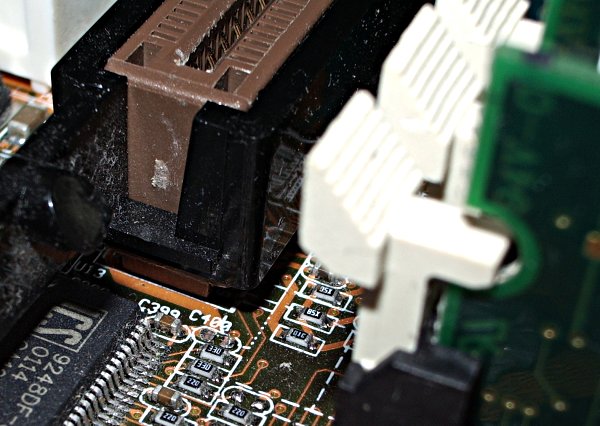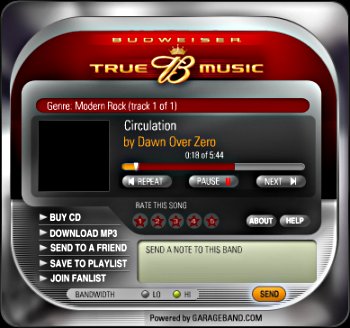03 Aug 2005
I wrote some months ago about my adventures with cleaning and rendering useless a motherboard that I’d found on the side of the road, in which I accidentally removed a surface-mounted capacitor from the surface it was mounted on (duh).

It appears that capacitor did absolutely nothing.
Earlier this afternoon, I played with a bunch of hardware trying to find some stuff that worked for Marcelo, before establishing that the best of the bunch, the motherboard I’d broken (or ‘broken’) — it seemed to be really good quality in the whole time I was playing with it — was absolutely fine. After much changing and plugging and everything else that’s involved in building a computer from scraps, we wound up with the following specs:
- Pentium 3 866
- Gigabyte 6VXC7-4X-P motherboard
- 384MB of RAM
- 16MB Voodoo3 (2000, I’m pretty sure… it had TV-out, too — as in the socket was there and soldered on — but the blanking plate covered it… go figure. Didn’t have time to pull it apart/an S-Video cable to test.) AGP
- Two hard drives… a 10GB (his original) and a 13GB (added)
And it all seems to work without any problems, despite missing that 400th capacitor lost one fateful day ;) Ah, I love technology when it just works even when it shouldn’t!
03 Aug 2005
I’ve just uploaded the Bake the Cake video from the beginning of the year to Ourmedia/Archive.org because my iiNet webspace ceased to exist some months ago now, and it lacked any other permanent home (with sufficient bandwidth).
It’s still just the WMV file, but I’m hoping to put a higher resolution version/different media format version up at some point in the future. You can grab the WMV file here, or view the video’s page on Ourmedia. If nothing else, consider this an experiment on my part with Ourmedia/Archive.org’s services.
02 Aug 2005
I wrote some time ago about Opera performing brilliantly and how, when Firefox collapsed on me (it’s still a bit shaky – middle-click opening of new tabs is now rather flawed, even in the ‘fixed’ release), I fell in love with it. Well, as much as one can with a piece of software, anyway.
I also wrote briefly of how Tori told me about a very cool media service called GarageBand, which publishes music from independent artists free of charge, even going so far as to offer (shock, horror) un-DRM-encumbered MP3 downloads of the vast majority of tracks.
So where does Flash fit into all of this?

Well. About that. GarageBand has this nifty Flash player thing going, which is very cool, except for when you’re using Firefox: every time I have it running whilst trying to do anything in the background (that is, within Firefox, in another tab or something), the audio buffer dies until whatever I’m doing in the background has started to render (or maybe resolved a host, or something… whatever).
Opera, on the other hand, handles this flawlessly. The window pops open, Flash loads faster (notably, using exactly the same plugin as the Mozilla family, if I recall correctly), and I can do whatever I want in the background without it skipping a beat. And that, ladies and gentlemen, is how a browser should be.
02 Aug 2005
Okay, this should hopefully be the last word from me on this. I’ve discovered there’s a bug report on this issue in Ubuntu’s Bugzilla system, which has some pretty informative comments.
I uninstalled Tabbrowser, Web Developer Toolbar and Image Zoom extensions (as well as FireFTP, but that’s just because I never use it anymore/it’s always been too clunky), then restarted Firefox — presto, the Preferences work again, as does myriad other things. I’ve reinstalled the Web Developer Toolbar extension as well as Image Zoom, and restarted, and now everything appears to be working as normal again.
02 Aug 2005

There’s a new TV network out there that’s got a radically different programming model, and looks immensely interesting. They’re foward-thinking type people. This is Cluetrain-model television programming. And I wish they’d gone and launched a video stream as well, because neither I (nor anyone else outside the US) can see any of it live – only what’s been specifically selected and uploaded to their online Current Studio section (not yet live).
(Oh, and if any US people are reading this — I’m looking at you, Matthom ;) — expecting a full report! :P)
I’d say some more nice things about them if their website were as foward thinking as they clearly are: they could easily have a validating website if they cared (look ma, no tables… also no doctype), and streaming is obviously not beyond their reach if they already have the facilities to provide some of their content selectively.


